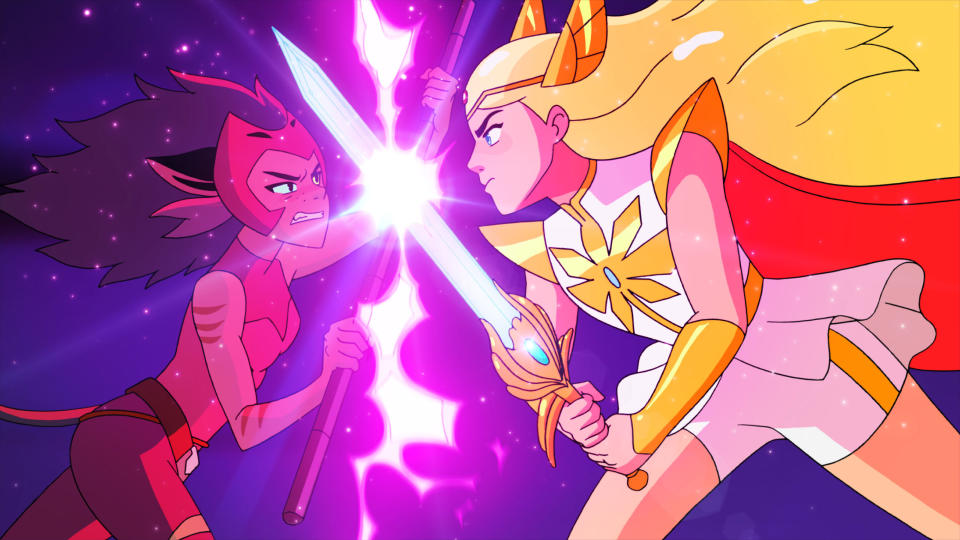She-Ra and the Princesses of Power is a funny-wonderful pop fantasy: EW review
We’re lousy with nostalgia-baiting TV revivals, but She-Ra and the Princesses of Power is something special. The new Netflix series (debuting Nov. 13) updates the ’80s swordtech cartoon into a heroically right-now parable about empowered women teamworking against terror. The result is a funny-wonderful pop fantasy animated like disco fireworks, fun for kids of all genders and any parents looking for something happy to cry about.
She-Ra takes place on Etheria, a cyber-magical planet where every climate zone is a fantasy landscape ruled by a monarchic lady elemental. Water princess, plant princess, snow princess, princess who does machines — and that’s just the opening credits, and they’re not even the lead characters!
The series follows Adora (Aimee Carrero), an effective teen soldier in a pollution-y army called the Horde. Adora’s an orphan raised for global conquest with a steady diet of anti-princess propaganda, but she starts to suspect she’s on the wrong side of history. That puts her at odds with Catra (AJ Michalka), a childhood friend and fellow Horder with dark intentions. But it also pushes her into the orbit of a couple anti-Horde rebels: teleportation princess Glimmer (Karen Fukuhara) and trickshot arrowmeister Bow (Marcus Scribner). And there’s also the matter of a mysterious sword Adora finds in the wilderness, an ancient weapon that transforms her into the shimmering red-caped warrior She-Ra.
1985’s She-Ra: Princess of Power was spun off from He-Man and the Masters of the Universe, and both series shared the internal logic of a crammed toybox: tanks versus sorcerers, loincloths atop cybernetics, various mystical beings from a spaced-out laser age. Season 1 of the new series is, roughly, a get-the-gang-together story, with Glimmer attempting to reform a long-dormant Princess Alliance against eerie tyrant Hordak (Keston John). Nothing sounds more like some Mattel executives’ mid-80s cocktail lunch than an evil “Horde” led by someone named “Hordak.” But the new She-Ra (the title pluralized with Princesses) uses the Lucky Charms marshmallows-y worldbuilding to spark cheerfully disparate adventure styles. There’s a pirate-ish voyage, a robo-labyrinth, a fairy-tale forest not far from a metropolitan dystopia.
And there’s a real sense of humor, self-aware without ever being snarky. She-Ra has a wild central mythology, with an ongoing mystery about obscure maybe-extraterrestrial ancient race with a Tronish pyramid aesthetic. But also, when you least expect it, the fate of the world depends on various characters attending a formal-dress invite-only royal prom.

I missed the old-school She-Ra: Princess of Power, partially because when it debuted I was a freshborn spud barely capable of perceiving shapes and colors. Though that’s not a very good excuse, since the new She-Ra‘s showrunner Noelle Stevenson wasn’t even around for the 1980s. A cartoonist who worked a bit on the blissful new DuckTales, Stevenson brings a mix of fan-ish enthusiasm and hiply transgressive newness. The reboot vibe here recalls the 2000s Battlestar Galactica, action-figure iconography grounded with wit and dark whimsy. Stevenson honors the basic plot layout and the birthday-cake radiance of old-school She-Ra. But the original cast of characters has been casually diversified, and newly illustrated to boldly suggest human beings have all shapes and sizes.
But in one respect, the new She-Ra feels fully formed on arrival. Catra reveals herself as an emotionally wounded bad-behavior anti-hero with motivations as complex as any family-friendly cartoon I’ve ever seen. Her antagonism with Adora lifts the series to another level. Lifelong friends, they’ve chosen radically different paths for unsteady reasons. Adora has a strong moral code built atop encompassing confusion about herself and her world. Catra’s more strong-willed, openly malicious, but she’s also operating from a legitimate feeling of betrayal (and, bonus, is a cool hang).
Anyone my age probably recalls certain clown comic elements in grade school identifying homoerotic undercurrents in Masters of the Universe, a subtext that now looks like the most heartening thing about the He-Man saga (at least in the learned analysis of my former colleague Adam B. Vary). She-Ra‘s a safe-for-kids show that never even gets around to explicit romance, but Stevenson and her collaborators take the fundamental glitter-camp style as an opportunity to fit some impressively complicated emotions into the undercurrents of the Adora-Catra relationship. Undercurrents, hell. There’s a pivotal moment where Adora dances with Catra, heroine in a magenta-fuschia dress, villainess rocking a sangria-colored tuxedo with an unwrapped bowtie, club lights around them casting a particular Bowie shade of pink, and then Catra dips Adora — wow!!
On She-Ra, the (retro-)future is female, with a cast of mostly women existing on a multi-dimensional spectrum: good, evil, good but solitary, evil but understandable, utterly amoral, full-blown hippie. Doesn’t take a brain surgery princess, though, to pinpoint the resonance here. Adora and her friends aren’t just trying to unite their world against tyranny. They’re trying to reunite an old all-female rebellion, a coalition of powerful liberal-minded thinkers left in disarray after a brutal defeat years ago by a monstrously all-consuming bad dude. The old Princess Rebellion failed, so why, certain characters ask, should the next generation even try?
“It went horribly for our parents,” Glimmer says. “But we have a chance to do it right. We’re clearly stronger together. Think what all the princesses united could do.” Indeed, just think about it, he wrote one anxious American Tuesday in November 2018. “We’re on the edge of greatness/turning darkness to light,” roars Aaliyah Rose in the She-Ra theme tune, “We must be strong/and we must be brave,” pardon me these appear to be tears in my eyes, “We gotta find every bit of strength that we have and never let it goooooo/WE MUST BE STRONG!!!” We must, we must, we must. B+

